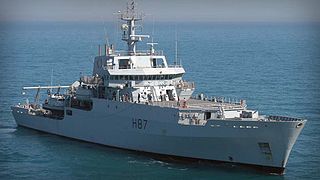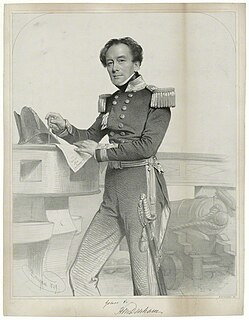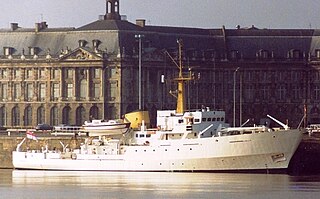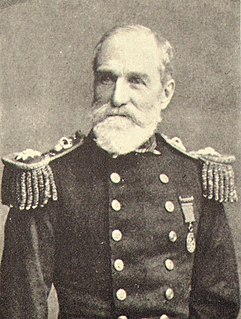
The Echo class is a class of multi-purpose hydrographic survey ships in commission with the Royal Navy. The ships are primarily tasked with conducting survey work in support of submarine and amphibious operations, however, the class also has a secondary role in mine countermeasures. The two vessels of the class are the most recent additions to the Royal Navy's Hydrographic Squadron. Each ship displaces approximately 3,700 tonnes, and is equipped with a state of the art suite of equipment.

HMS Enterprise, the tenth ship to bear this name, is a multi-role survey vessel - hydrographic oceanographic (SVHO) of the Royal Navy. She has a sister ship, HMS Echo, and together they make up the Echo class of survey vessels.
HMS Hecate (A137) was a Royal Navy deep ocean survey vessel of the Hecla class. She was present at the "presentation of fleet colours" review in Torbay on 29 July 1969. The ship was decommissioned in 1990.

HMS Herald was a Hecla-class ocean survey ship that served with the Royal Navy during both the Falklands War and Gulf War.

HMS Hydra was a Royal Navy deep ocean hydrographic survey vessel, the third of the original three of the Hecla class. The ship was laid down as yard number 2258 on 14 May 1964 at Yarrow Shipbuilders, at Scotstoun on the River Clyde and launched on 14 July 1965 by Mary Lythall, wife of the then Chief Scientist, Basil W Lythall CB (1919–2001). She was completed and first commissioned on 4 May 1966 and, as the replacement for the survey ship HMS Owen, her commanding officer and many of her ship's company formed the first commission of HMS Hydra. She was decommissioned and sold to the Indonesian Navy in 1986 and renamed KRI Dewa Kembar ; she was still in service in 2019.

The United Kingdom Hydrographic Office (UKHO) is the UK's agency for providing hydrographic and marine geospatial data to mariners and maritime organisations across the world. The UKHO is a trading fund of the Ministry of Defence (MoD) and is located in Taunton, Somerset, with a workforce of approximately 900 staff.

A research vessel is a ship or boat designed, modified, or equipped to carry out research at sea. Research vessels carry out a number of roles. Some of these roles can be combined into a single vessel but others require a dedicated vessel. Due to the demanding nature of the work, research vessels are often constructed around an icebreaker hull, allowing them to operate in polar waters.

Vice Admiral Sir Henry Mangles Denham was a Royal Navy officer who went on to be Commander-in-Chief, Pacific Station.

HMS Beagle was a Bulldog class coastal survey vessel of the Royal Navy and was the ninth to bear the name.
Six ships of the Royal Navy have borne the name HMS Fawn:

Rear-Admiral Sir Edmund George Irving, was a naval hydrographer.
Rear-Admiral Sir David William Haslam was a Royal Navy officer.

HMS Fawn was a Royal Navy 17-gun Cruizer-class sloop launched in 1856. She served on the Australia, North America and Pacific stations before being converted to a survey ship in 1876. She was sold and broken up in 1884.

Admiral Sir William James Lloyd Wharton was a British admiral and Hydrographer of the Navy.

Earle Island is a small ice-free island 6 kilometres (3 nmi) south-west of Darwin Island which marks the south-western end of the Danger Islands. Following hydrographic work in the area from HMS Endurance in 1977–78, it was named, in association with Beagle Island and other names in the group, after Augustus Earle, an artist on board HMS Beagle.
Rear-Admiral George Stephen "Steve" Ritchie CB DSC was a British admiral noted for his cartographic and hydrographic work.
Rear Admiral Bruce Kafer, is a senior Royal Australian Navy officer and former Commandant of the Australian Defence Force Academy, a position he held from December 2009 until December 2013. Kafer served as the Director-General of the Australian Navy Cadets and Reserves from December 2014 to December 2016, when he was appointed Head of the Cadet, Reserve and Employer Support Division.

Admiral Sir Arthur Mostyn Field, was a senior officer in the Royal Navy who served as Hydrographer of the Navy from 1904 to 1909.
This page is based on this
Wikipedia article Text is available under the
CC BY-SA 4.0 license; additional terms may apply.
Images, videos and audio are available under their respective licenses.













